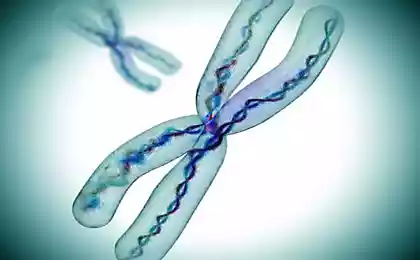631
What genes give superpowers
While we were sweltering in the gym or in horror waiting for a hangover after a glass of champagne, this lucky all come for free. Is it true that genetics someone generously handing out gifts, and someone leaves with a constant feeling of hunger?
True. And we in the "Atlas" There are several examples that confirm these words.

BHLHE41: Sleep is for wimps
This gene encodes a protein that is involved in DNA transcription (copying rewriting text) as the suppressor. In addition to this important work, BHLHE41 gene responsible for regulating circadian rhythms - our biological clock. In part, they are related to external factors - the change of day and night, but by their nature are endogenous even in isolation from sunlight, and the circadian rhythm of the planet, we go to bed and wake up. Human cycle equals 24-25 hours, of which we need to sleep 7-8 hours. However, mutational variation BHLHE41 gene can make their own adjustments to our schedule: some lucky people in their genetic nature manage to sleep for 5-6 hours
.
ADH1B & amp; ALDH2: I'll quit tomorrow drink
Two genes encode enzymes involved in the metabolism of alcohol - alcohol dehydrogenase and acetaldehyde dehydrogenase. The process takes place in two stages: first ADH1B splits ethanol to acetaldehyde - and alcohol intoxication is over. But the hangover begins: acetaldehyde - a toxic and its presence in the blood is poisoned with all the consequences: headache, nausea, dizziness. This continues for as long as the second enzyme ALDH2 not be straightened with acetaldehyde and not turn it into vinegar (bezverdny and secure to the low concentration, in which it is formed).
Well coordinated work of two genes helps the body cope with the alcohol so quickly that you do not have time to tell a story or a drunken nonsense, nor to suffer a hangover (a real James Bond). Variations in these two genes lead to interesting consequences. If the first ADH1B gene works well, and the second ALDH2 - bad, alcohol is rapidly cleaved to acetaldehyde, but beyond that it does not go. Pleasant intoxication quickly evaporate, and there will come a long heavy hangover: red face, rapid heart beat - everything that we associate with intolerance to alcohol. If on the contrary, the first gene of keeping up with their work, while the second breaks down quickly hangover poison, you will find a long state of intoxication, no hangover in the morning cucumber. It sounds very attractive, but do not rush to be jealous of such powers: since the drinks do not have to pay poor health, these superheroes higher probability of alcohol dependence
.
FTO: close your refrigerator
Fat Mass And Obesity Associated - is the full name of the gene that encodes the protein and energy metabolism is responsible for the whole. The work of this gene is associated with the onset of satiety. A certain variant of a gene may result in some it comes too late: for example, twenty minutes after the body was sated and really got everything you need. Of course, twenty extra minutes of overeating can lead - and lead - to obesity. A genetic superheroes with the normal variant of the FTO gene may eat and not get fat (though they eat a little).

Tas1r3: and from windows with pastries too Depart
Another reason for the increased weight (and the level of glucose in the blood) - a love of sweets. Evolution has played with us a very cruel joke. At the dawn of mankind, it has taught us to choose sugary foods: they are more likely to be nourishing and not poisonous. But after a couple of million years of the same gene instead lead us to useful products leaves us alone in front of the glittering showcase highlights calorie cheesecake, profiteroles and eclairs. Someone lucky sensitivity to sweet they are normal, and dessert for them is not so important. The rest - unhappy with a reduced sense of sweet - it is never enough and always want more.

FTO / SLC30A8: jogging in the morning every day
Once out of nowhere appeared extra weight, we go to the gym. But here, we will be disappointed: someone is engaged in every day and quickly came to the form, and others have more than squat and catch up - and it seems that everything is in vain. The fitness club plays an important role already familiar FTO gene: but the desire to eat it determines the effectiveness of physical activity and the rate of burning body fat during exercise. Some people, alas, have to work harder to achieve the same or lower results.
Another gene - SLC30A8 - encodes zinc transporter protein, which is involved in the synthesis of insulin. He is responsible for the recovery rate after exercise. Wrong genotype may increase the recovery time of up to 48-72 hours between workouts: Doing more often is simply useless.

CCR5: resistance to HIV
The rapid burning of fat mass and rigidity to the sweet look toy superpowers in the face of the Superman: a gene of resistance to HIV. It encodes a protein CCR5 chemokine receptor, which plays an important role in the immune system. A certain gene mutation makes it impossible for the accession of HIV to T-cells: this is an inherent and lifelong vaccination. People with a genetic "vaccine" from 5% to 14% (data for the European population). Unfortunately, there is also a side effect: apparently, this type CCR5 gene increases the risk of West Nile fever, and multiple sclerosis
.
Most likely, any reader of this text have genetic superpowers. Which -pokazhet genetic test.
Source: geektimes.ru/company/atlasbiomed/blog/277996/
True. And we in the "Atlas" There are several examples that confirm these words.

BHLHE41: Sleep is for wimps
This gene encodes a protein that is involved in DNA transcription (copying rewriting text) as the suppressor. In addition to this important work, BHLHE41 gene responsible for regulating circadian rhythms - our biological clock. In part, they are related to external factors - the change of day and night, but by their nature are endogenous even in isolation from sunlight, and the circadian rhythm of the planet, we go to bed and wake up. Human cycle equals 24-25 hours, of which we need to sleep 7-8 hours. However, mutational variation BHLHE41 gene can make their own adjustments to our schedule: some lucky people in their genetic nature manage to sleep for 5-6 hours
.

ADH1B & amp; ALDH2: I'll quit tomorrow drink
Two genes encode enzymes involved in the metabolism of alcohol - alcohol dehydrogenase and acetaldehyde dehydrogenase. The process takes place in two stages: first ADH1B splits ethanol to acetaldehyde - and alcohol intoxication is over. But the hangover begins: acetaldehyde - a toxic and its presence in the blood is poisoned with all the consequences: headache, nausea, dizziness. This continues for as long as the second enzyme ALDH2 not be straightened with acetaldehyde and not turn it into vinegar (bezverdny and secure to the low concentration, in which it is formed).
Well coordinated work of two genes helps the body cope with the alcohol so quickly that you do not have time to tell a story or a drunken nonsense, nor to suffer a hangover (a real James Bond). Variations in these two genes lead to interesting consequences. If the first ADH1B gene works well, and the second ALDH2 - bad, alcohol is rapidly cleaved to acetaldehyde, but beyond that it does not go. Pleasant intoxication quickly evaporate, and there will come a long heavy hangover: red face, rapid heart beat - everything that we associate with intolerance to alcohol. If on the contrary, the first gene of keeping up with their work, while the second breaks down quickly hangover poison, you will find a long state of intoxication, no hangover in the morning cucumber. It sounds very attractive, but do not rush to be jealous of such powers: since the drinks do not have to pay poor health, these superheroes higher probability of alcohol dependence
.

FTO: close your refrigerator
Fat Mass And Obesity Associated - is the full name of the gene that encodes the protein and energy metabolism is responsible for the whole. The work of this gene is associated with the onset of satiety. A certain variant of a gene may result in some it comes too late: for example, twenty minutes after the body was sated and really got everything you need. Of course, twenty extra minutes of overeating can lead - and lead - to obesity. A genetic superheroes with the normal variant of the FTO gene may eat and not get fat (though they eat a little).

Tas1r3: and from windows with pastries too Depart
Another reason for the increased weight (and the level of glucose in the blood) - a love of sweets. Evolution has played with us a very cruel joke. At the dawn of mankind, it has taught us to choose sugary foods: they are more likely to be nourishing and not poisonous. But after a couple of million years of the same gene instead lead us to useful products leaves us alone in front of the glittering showcase highlights calorie cheesecake, profiteroles and eclairs. Someone lucky sensitivity to sweet they are normal, and dessert for them is not so important. The rest - unhappy with a reduced sense of sweet - it is never enough and always want more.

FTO / SLC30A8: jogging in the morning every day
Once out of nowhere appeared extra weight, we go to the gym. But here, we will be disappointed: someone is engaged in every day and quickly came to the form, and others have more than squat and catch up - and it seems that everything is in vain. The fitness club plays an important role already familiar FTO gene: but the desire to eat it determines the effectiveness of physical activity and the rate of burning body fat during exercise. Some people, alas, have to work harder to achieve the same or lower results.
Another gene - SLC30A8 - encodes zinc transporter protein, which is involved in the synthesis of insulin. He is responsible for the recovery rate after exercise. Wrong genotype may increase the recovery time of up to 48-72 hours between workouts: Doing more often is simply useless.

CCR5: resistance to HIV
The rapid burning of fat mass and rigidity to the sweet look toy superpowers in the face of the Superman: a gene of resistance to HIV. It encodes a protein CCR5 chemokine receptor, which plays an important role in the immune system. A certain gene mutation makes it impossible for the accession of HIV to T-cells: this is an inherent and lifelong vaccination. People with a genetic "vaccine" from 5% to 14% (data for the European population). Unfortunately, there is also a side effect: apparently, this type CCR5 gene increases the risk of West Nile fever, and multiple sclerosis
.

Most likely, any reader of this text have genetic superpowers. Which -pokazhet genetic test.
Source: geektimes.ru/company/atlasbiomed/blog/277996/
Highway Hi-Fi: the world's first stereo vinyl car from Chrysler
10 Secrets of the Chinese treatise Gui Gu Zi























